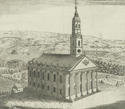 After the Reformation, architectural activity shifted away from the Cathedral to the mercantile area around Glasgow Cross where a number of municipal or corporate buildings were constructed to cater for the increasingly commercial activity. The buildings, which tended to be large, stone-built and several storeys tall, often ranged around a courtyard and were marked out by a steeple. These steeples are the most distinctive features of the burgh seen in the background of Slezer's View of Glasgow Cathedral (1693) and they have proved the most enduring. The most conspicuous survivals are from lost buildings: the Tolbooth, the Tron Church and the Merchants' House.
After the Reformation, architectural activity shifted away from the Cathedral to the mercantile area around Glasgow Cross where a number of municipal or corporate buildings were constructed to cater for the increasingly commercial activity. The buildings, which tended to be large, stone-built and several storeys tall, often ranged around a courtyard and were marked out by a steeple. These steeples are the most distinctive features of the burgh seen in the background of Slezer's View of Glasgow Cathedral (1693) and they have proved the most enduring. The most conspicuous survivals are from lost buildings: the Tolbooth, the Tron Church and the Merchants' House.
 The Tolbooth was erected in 1625-27 to serve as the municipal building and jail. The seven-storey square tower stands thirty-nine metres high and is lightly ornamented in a Jacobean Scottish style. The crown spire, which originally covered twenty-eight bells, is more medieval in character. The tower stood two storeys higher than the main building which fronted onto the Trongate until its demolition in 1812.
The Tolbooth was erected in 1625-27 to serve as the municipal building and jail. The seven-storey square tower stands thirty-nine metres high and is lightly ornamented in a Jacobean Scottish style. The crown spire, which originally covered twenty-eight bells, is more medieval in character. The tower stood two storeys higher than the main building which fronted onto the Trongate until its demolition in 1812.
 The Tron Spire, which emulates that of the cathedral, is all that remains of the City Kirk (formerly the collegiate church of St Mary and St Anne), and which was provided with a tower and steeple when it was rebuilt in 1636. The steeple of the Merchants' House (1665), now enclosed within the old Fish Market on the Bridgegate, originally towered over a two-storey nine-bay symmetrical facade, which has been attributed to Sir William Bruce. This steeple, like the Tron's, is essentially medieval in character.
The Tron Spire, which emulates that of the cathedral, is all that remains of the City Kirk (formerly the collegiate church of St Mary and St Anne), and which was provided with a tower and steeple when it was rebuilt in 1636. The steeple of the Merchants' House (1665), now enclosed within the old Fish Market on the Bridgegate, originally towered over a two-storey nine-bay symmetrical facade, which has been attributed to Sir William Bruce. This steeple, like the Tron's, is essentially medieval in character.
 The Old College (University) buildings on the High Street also boasted an impressive forty-three-metre steeple at the heart of a double quadrangle (1632-61). The buildings are lightly ornamented in a Scottish Jacobean style with most of the decorative detail focused upon the main entrance facade at the centre of the three-storey, twelve-bay elevation. The Old College is recognised as one of the finest structures built in 17th century Scotland, yet it was demolished to make way for the railway in 1885.
The Old College (University) buildings on the High Street also boasted an impressive forty-three-metre steeple at the heart of a double quadrangle (1632-61). The buildings are lightly ornamented in a Scottish Jacobean style with most of the decorative detail focused upon the main entrance facade at the centre of the three-storey, twelve-bay elevation. The Old College is recognised as one of the finest structures built in 17th century Scotland, yet it was demolished to make way for the railway in 1885.
 The real break with medieval architectural tradition took place in the early 18th century when members of the merchant class adopted classically influenced architectural styles for their town mansions. The most celebrated was Colin Campbell's Shawfield Mansion (1712), which was one of the earliest Palladian villas in Britain. Although none of the mansions of the "Tobacco Lords" survive, St Andrew's Parish Church remains as a testament to their wealth and taste. This, the first new church built in Glasgow after the Reformation, employed the new classical metropolitan style, which had hitherto been confined to private dwellings.
The real break with medieval architectural tradition took place in the early 18th century when members of the merchant class adopted classically influenced architectural styles for their town mansions. The most celebrated was Colin Campbell's Shawfield Mansion (1712), which was one of the earliest Palladian villas in Britain. Although none of the mansions of the "Tobacco Lords" survive, St Andrew's Parish Church remains as a testament to their wealth and taste. This, the first new church built in Glasgow after the Reformation, employed the new classical metropolitan style, which had hitherto been confined to private dwellings.